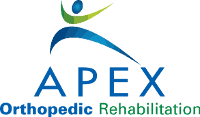
Football season is in full swing and I’ve been spending a good chunk of time on the field watching my kids play. As a Physical Therapist, this season also means it’s the time when I see an increase of patients with painful hamstring tears due to football. In my experience, I’ve also treated plenty of rugby players, runners and dancers with hamstring tears. I would argue that adult softball is right up there, as well, but I don’t have the statistics to support it; my evidence is witnessing injuries suffered by the “weekend warriors” in our local softball league. High speed running is often linked to why some of these sports put athletes at a higher risk.
The hamstring isn’t a single “string”, but a group of three muscles that run along the back of your thigh. It is made of the biceps femoris (long and short head), semitendinosis and semimembranosus that originate at the pelvic girdle/posterior femur and attach to the upper tibia and fibula head. The nerve supply to the hamstrings is provided sciatic nerve and common peroneal.
The primary actions of the hamstring muscle group are to extend the hip and flex the knee, functioning as a one and two joint muscle. The hamstring group plays a crucial role in many daily activities, such as walking, running, jumping and controlling some movement in the trunk. Injuries to this muscle group occur most frequently during the lengthening or eccentric phase of the muscular contraction when the hip is flexed (brought forward) and the knee is flexed (straightened).
A hamstring injury is most often associated with the following:
• audible pop and/or sudden onset
• sudden loss of flexibility
• difficulty walking
• pain ranges from mild to severe
• possible bruising in moderate to severe cases
During the examination, the findings typically include:
• loss of flexibility of hamstrings
• pain and weakness during strength testing of hamstrings
• tenderness at site of injury
• swelling and bruising at site of injury
Hamstring strain Injuries are classified as grade 1 (mild), grade 2 (moderate) or grade 3 (severe), which is often considered a full tear of the hamstring. The rate of recovery can vary from 2-3 weeks to 2-3 months. If you return to full participation too early, it often leads to a re-injury. Location of the hamstring tear has some impact on the length of the recovery. If the tears are closer to the attachment of the biceps femoris, it is considered more severe as compared to the mid-portion of the hamstring muscle group. Only in cases of severe injuries is a diagnosis is made using a magnetic resonance imaging (MRI) and x-rays are only used in the case of avulsion where a piece of bone is torn at the attachment of the hamstring.
A proper diagnosis is key. In some cases, pain believed to be a hamstring tear can be related to other conditions like a herniated disc, hip osteoarthritis, sacroiliac joint problems, sciatica and/or meniscal tears.
Here are my top 4 steps you can do to avoid a hamstring strain injury:
• Improve flexibility of the hamstring, most importantly in addition to the quadriceps and calf muscles. A higher number of these injuries occur during the maximal stretch of the hamstrings where it is at its weakest position.
• Engage in an eccentric strengthening program. A program would include exercises that focus on the lengthening of the muscle or eccentric phase when most injuries occur.
• Engage in sport specific training. Concentrate on a progressive running program that mimics the demand of the sport. Most times people engage in jogging or running exercise programs that never mimic the demands of their sport that require a full out sprint. If your sport requires sprinting and sudden stops, incorporate that into your preparation.
• Ensure you do a dynamic warm up for 10-15 minutes prior to competing in your sport. An inherent problem with certain sports is extended periods of inactivity followed by a full out sprint (i.e. softball outfielder).
Be sure to get some professional guidance on this type of injury because if it’s not managed properly, it can reoccur and become a continual limitation to enjoying any sport that requires running. This type of injury is very common and difficult to rehabilitate, even for professionals.
Apex Orthopedic Rehabilitation in Wyckoff, NJ provides orthopedic, spine and sports physical therapy services for the greater Ridgewood, Wyckoff, and Bergen County region. This blog is intended for informational purposes only and should not be used for diagnostic or prescriptive purposes. The views expressed here are the author’s views and should be taken as suggestions. Always consult your doctor or healthcare practitioner before engaging in a physical therapy or rehabilitative program.


